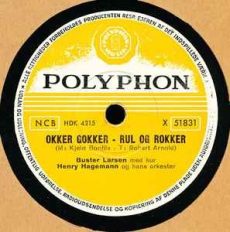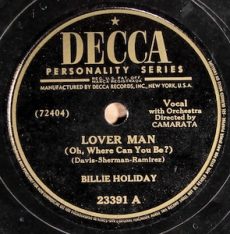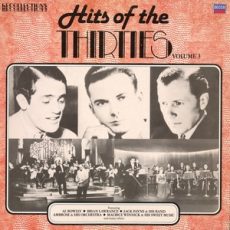
Daily Dose Of Jazz…
Henry Hagemann was born on September 6, 1910 in Copenhagen, Denmark He became a professional musician in 1931 and played primarily saxophone and clarinet. Throughout his career, he played with Kai Ewans, Winstrup Olesen and Leo Mathisen, among others.
From 1944 to 1949 he led his own ensemble. Afterward he performed as a theater musician, first with Hans Schreiber in the Fiffer revues and later in the Circus revue . He has also been engaged at the New Scala, where he regularly served as bandmaster.
Saxophonist and clarinetist Henry Hagemann died April 5, 1964.
More Posts: bandleader,clarinet,history,instrumental,jazz,music,saxophone

Daily Dose Of Jazz…
Sammy Weiss was born on September 1, 1910 in New York. He started in the 1930s with the Gene Kardos Society Orchestra, then gigged and recorded with Benny Goodman, Adrian Rollini, Wingy Manone, Miff Mole, Tommy Dorsey and Artie Shaw.
The 1940’s had Sammy concentrated on free-lance recording with Louis Armstrong and Johnny Guarnieri. He eventually led his own popular dance band in hotels and dance halls around Los Angeles, California.
He also worked with Louis Armstrong, Paul Whiteman, Louis Prima, and Erskine Hawkins, among others. After moving to California in 1945, Weiss led his own successful orchestra and worked freelance. He led bands throughout the ’60s, As an actor, Weiss was seen in Shower of Stars and The Jack Benny Program.
Drummer Sammy Weiss died on November 18, 1977 in Encino, California.
More Posts: drums,history,instrumental,jazz,music

Daily Dose Of Jazz…
James Benjamin Sherman was born on August 17, 1908 in Williamsport, Pennsylvania. He played piano in dance bands in the late 1920s and played on and off with Jimmy Gorham in the metropolitan Philadelphia area. In 1930 he began playing on a steamboat in Alphonso Trent’s band, then played in the 1930s with Peanuts Holland, Al Sears, Stuff Smith, Lil Armstrong, Putney Dandridge, Mildred Bailey, and Billie Holiday.
From the mid- to late ’30s Jimmy played in various swing groups but is best known for his hand in composing the jazz standard Lover Man, co-written with Jimmy Davis and Roger Ramirez, and was first recorded by Billie Holiday
He became the pianist and arranger for The Charioteers in 1938, remaining with the group until 1952. Following this he played primarily locally in eastern Pennsylvania. In 1960 he took up a residency at Miss Jeanne’s Crossroad Tavern in Chester County, Pennsylvania, where he played until shortly before his death.
Pianist and arranger Jimmy Sherman died on October 11, 1975 in Philadelphia, Pennsylvania.
More Posts: arranger,bandleader,composer,history,instrumental,jazz,music,piano

Daily Dose Of Jazz…
Leslie Priestley Carew was born on August 15, 1908 in London, England but spent his formative years in Shipley, Yorkshire. The son of theatrical parents, it wasn’t till after working in the local mills in his post-school years that he found himself drawn to music and the trombone, upon which he progressed rapidly.
Known to the music world as Les, he began playing in dance bands and eventually returned to London and caught the eye and ear of Jack Hylton. In the 1930s he became a featured trombonist in the Jack Hylton Orchestra during their international heyday performing all over Europe.
He was known for his comedic performances, as an actor and a natural comedian, Carew appeared with his Hylton bandmates in films She Shall Have Music (1935), The Playboy (1938) and Calling All Stars (1937).
Leaving Hylton in the Forties he added vocals to his performance arsenal and recorded as a member of Bert Ambrose and His Orchestra. By the time World War II ensued, military service was curtailed by health deficiencies, and during the latter part of it he led the Ambrose Octet.
After the war Carew freelanced in London with Geraldo, Eric Robinson, Mantovani, George Melachrino and many others. In 1970 his first wife, Elsie, died and he subsequently married the music lecturer Avril Dankworth – founder of the children’s music camps bearing her name – a partnership which lasted the rest of his life.
Trombonist Les Carew died of Parkinson’s disease, shortly after completing his autobiography in 1994 in St Albans, Hertfordshire, England.

Daily Dose Of Jazz…
Lew Davis was born on August 4, 1903 in London, England. His early childhood and education is unknown or when he picked up the trombone. He began playing with Jack Hylton And His Orchestra as the only trombonist on recordings from 1923 to 1928. He then joined Leo Vauchant before moving on to become a part of Paul Fenhoulet’s band.
The Thirties saw Lew with Ray Noble, Ambrose & His Orchestra, Lew Stone & The Monseigneur Band, as well as his own Lew Davis Trombone Trio. He went on to work with Benny Carter And His Orchestra, Jack Harris & His Orchestra, Ronnie Munro & His Orchestra, Savoy Hotel Orpheans, and Louis de Vries And His Rhythm Boys.
Trombonist Lew Davis dided in London on November 24, 1986.
More Posts: bandleader,history,instrumental,jazz,music,trombone



